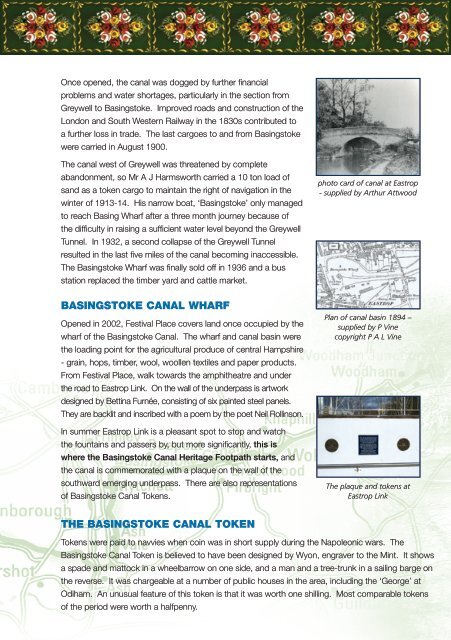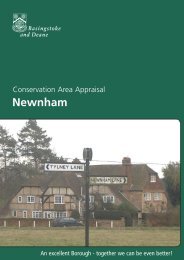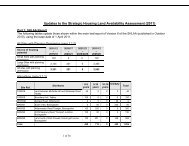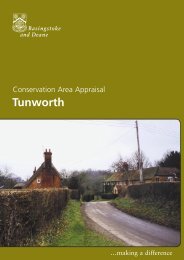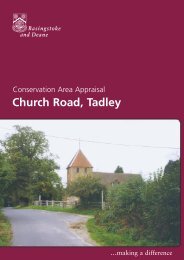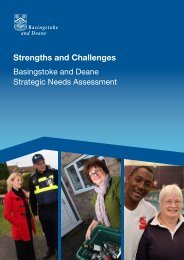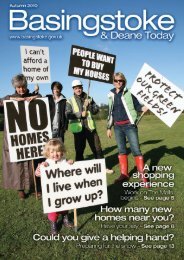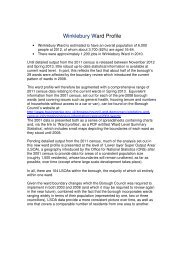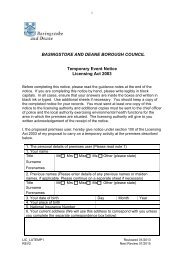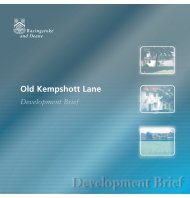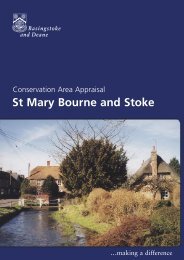Canal Heritage Footpath - Basingstoke and Deane Borough Council
Canal Heritage Footpath - Basingstoke and Deane Borough Council
Canal Heritage Footpath - Basingstoke and Deane Borough Council
You also want an ePaper? Increase the reach of your titles
YUMPU automatically turns print PDFs into web optimized ePapers that Google loves.
Once opened, the canal was dogged by further financial<br />
problems <strong>and</strong> water shortages, particularly in the section from<br />
Greywell to <strong>Basingstoke</strong>. Improved roads <strong>and</strong> construction of the<br />
London <strong>and</strong> South Western Railway in the 1830s contributed to<br />
a further loss in trade. The last cargoes to <strong>and</strong> from <strong>Basingstoke</strong><br />
were carried in August 1900.<br />
The canal west of Greywell was threatened by complete<br />
ab<strong>and</strong>onment, so Mr A J Harmsworth carried a 10 ton load of<br />
s<strong>and</strong> as a token cargo to maintain the right of navigation in the<br />
winter of 1913-14. His narrow boat, ‘<strong>Basingstoke</strong>’ only managed<br />
to reach Basing Wharf after a three month journey because of<br />
the difficulty in raising a sufficient water level beyond the Greywell<br />
Tunnel. In 1932, a second collapse of the Greywell Tunnel<br />
resulted in the last five miles of the canal becoming inaccessible.<br />
The <strong>Basingstoke</strong> Wharf was finally sold off in 1936 <strong>and</strong> a bus<br />
station replaced the timber yard <strong>and</strong> cattle market.<br />
<strong>Basingstoke</strong> <strong>Canal</strong> Wharf<br />
Opened in 2002, Festival Place covers l<strong>and</strong> once occupied by the<br />
wharf of the <strong>Basingstoke</strong> <strong>Canal</strong>. The wharf <strong>and</strong> canal basin were<br />
the loading point for the agricultural produce of central Hampshire<br />
- grain, hops, timber, wool, woollen textiles <strong>and</strong> paper products.<br />
From Festival Place, walk towards the amphitheatre <strong>and</strong> under<br />
the road to Eastrop Link. On the wall of the underpass is artwork<br />
designed by Bettina Furnée, consisting of six painted steel panels.<br />
They are backlit <strong>and</strong> inscribed with a poem by the poet Neil Rollinson.<br />
In summer Eastrop Link is a pleasant spot to stop <strong>and</strong> watch<br />
the fountains <strong>and</strong> passers by, but more significantly, this is<br />
where the <strong>Basingstoke</strong> <strong>Canal</strong> <strong>Heritage</strong> <strong>Footpath</strong> starts, <strong>and</strong><br />
the canal is commemorated with a plaque on the wall of the<br />
southward emerging underpass. There are also representations<br />
of <strong>Basingstoke</strong> <strong>Canal</strong> Tokens.<br />
photo card of canal at Eastrop<br />
- supplied by Arthur Attwood<br />
Plan of canal basin 1894 –<br />
supplied by P Vine<br />
copyright P A L Vine<br />
The plaque <strong>and</strong> tokens at<br />
Eastrop Link<br />
THE BASINGSTOKE CANAL TOKEN<br />
Tokens were paid to navvies when coin was in short supply during the Napoleonic wars. The<br />
<strong>Basingstoke</strong> <strong>Canal</strong> Token is believed to have been designed by Wyon, engraver to the Mint. It shows<br />
a spade <strong>and</strong> mattock in a wheelbarrow on one side, <strong>and</strong> a man <strong>and</strong> a tree-trunk in a sailing barge on<br />
the reverse. It was chargeable at a number of public houses in the area, including the ‘George’ at<br />
Odiham. An unusual feature of this token is that it was worth one shilling. Most comparable tokens<br />
of the period were worth a halfpenny.


